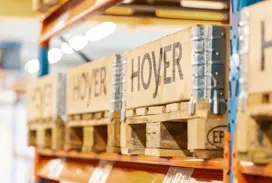
Five lessons learned: How do you create a successful export business?
Hoyer can now call itself Danish Exporter of the Year 2016, and the company’s CEO emphasises five specific building blocks that can help lay the groundwork for growth in export markets.
In 1997, Hoyer took its first steps outside Denmark by making Norway its first export market. This was followed by Sweden and Germany and that’s how things continued up to the present when Hoyer is now active in twenty countries in Europe and Asia.
The long-standing progress as an export company was recognised in February 2017 by being named Danish Exporter of the Year, a prize awarded every year to one of its 570 members.
“Impressive growth is not the only thing Hoyer has experienced in recent years. They have also shown how customer understanding and a strategic approach to collaboration pay off,” says Ulrik Dahl, CEO, Danish Export Association, adding:
We recently saw how quickly and efficiently they penetrated the Japanese market, something that usually takes years of instilling trust. Hoyer has a collective devil-may-care attitude, where the entire organisation simply focuses on whatever they launch.
The CEO’s five reflections:
Thomas Klausen, CEO of Hoyer, highlights five lessons learned that help build a successful export business.
Decide on you want to be good at
It’s essential to know what you want to be good at – and that you keep being good at it. When you want a customer on board, you must be able to tell them how your product creates value. Of course, everyone looks at the price tag, but their focus shifts when you contribute in other areas. At Hoyer, we decided on being renowned for documentation, high product performance and the best service in the industry. This is essential, regardless of which market we’re trying to penetrate.
Acknowledge cultural differences
You need deep cultural understanding to build success in a foreign country. In Asia, an accidental slip of the hand can be offensive. And then you don’t land the sale. We decided to employ locals who naturally speak the language, but also are familiar with the customs to follow when meeting customers and negotiating. This is the best way to ensure insight into and an understanding of the customer’s situation.
Make sure to create awareness
Regardless of how strong a product us, growth doesn’t happen by itself. You need to draw attention to your presence in the industry to which you want to sell your products. You can do this by attending trade fairs and employing local salespeople, who will target prospective companies. In my experience, entering a new country requires a degree of acceptance. Once a customer decides to go with us, we often see interest accelerate significantly in the relevant market.
Avoid countries with export barriers.
Some countries can be tough to get involved in. There is no reason to make them your first target. For example, we were reluctant to start up in the US, because we didn’t know the specific terms or conditions that would apply to a foreign company that wanted to sell its products there. We decided to focus on markets that don't have limitations on Danish exports. And there are still plenty of those left before we need to look at countries posing bigger challenges.
Believe in your success.
It may sound trite, but it’s essential to have the will to succeed. You must believe in your product and the things you’ve decided to be good at. In other words believe that you can succeed in the markets you’ve decided to penetrate. We have an excellent organisation that is dedicated to its work and that wants to succeed. And obviously having a great product, an excellent strategy and enthusiastic employees give you a foundation for further export growth.
Facts
- Since 2010, the company’s export sales have grown from 50% of turnover to 75% of turnover in 2016.
- In the same period, the company as a whole grew 300%.
- Hoyer recently set up sales offices in Japan and Dubai as part of its export strategy.

